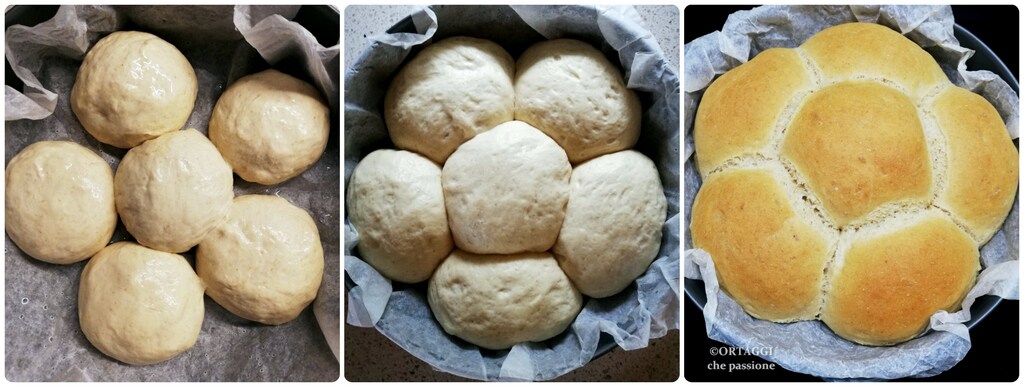This simple recipe for making bread with dried sourdough uses type 2 flour (semi-whole) and semolina. The dried sourdough gives the bread a unique flavor and enriches its texture. With a few quick steps, you can create fragrant, aromatic, soft, and light bread. Follow this easy recipe to enjoy the pleasure of homemade baking and experience the authentic taste of homemade bread.
Other homemade BREAD RECIPES

- Difficulty: Medium
- Cost: Economical
- Rest time: 3 Hours
- Preparation time: 20 Minutes
- Portions: 1 round baking tray d.9.5-10.3 inches of flower-shaped bread
- Cooking methods: Oven
- Cuisine: Healthy
- Seasonality: All seasons
- Energy 252.37 (Kcal)
- Carbohydrates 47.43 (g) of which sugars 1.08 (g)
- Proteins 7.97 (g)
- Fat 3.18 (g) of which saturated 0.35 (g)of which unsaturated 0.00 (g)
- Fibers 2.04 (g)
- Sodium 154.90 (mg)
Indicative values for a portion of 100 g processed in an automated way starting from the nutritional information available on the CREA* and FoodData Central** databases. It is not food and / or nutritional advice.
* CREATES Food and Nutrition Research Center: https://www.crea.gov.it/alimenti-e-nutrizione https://www.alimentinutrizione.it ** U.S. Department of Agriculture, Agricultural Research Service. FoodData Central, 2019. https://fdc.nal.usda.gov
Bread with Dried Sourdough
The quantity (weight) of the two flours can vary according to your needs, the important thing is that the total is 500 grams.
- 250 g type 2 flour (or type 1 or whole wheat)
- 250 g remilled durum wheat semolina
- 10 g dried sourdough (natural yeast + dry yeast)
- 1 teaspoon sugar (or honey, syrup, barley malt)
- 20 g extra virgin olive oil (or peanut oil)
- 300 ml water (at room temperature – 77°F)
- 1 teaspoon salt (from 3 to 10 g according to taste)
Homemade Bread with Dried Sourdough
In a large bowl (or in the stand mixer), mix together the flours (500 g), dried sourdough (10 g), sugar (one teaspoon), room temperature water (300 ml), and oil (20 g).
Once the ingredients are well combined and have formed a cohesive dough, transfer it to the work surface and add salt (from 3 to 10 grams according to taste), continue kneading until you obtain a smooth and elastic dough. This will take about 10 minutes.
Place the dough back in the bowl and cover it with a lid (or a damp towel) and let it rise until it doubles or better triples in volume, away from drafts (which can compromise the rising). I place it in the oven turned off and preheated to 122°F (50°C) for 1-2 hours.
Meanwhile, line the baking tray with wet and squeezed parchment paper.
Once the dough has risen, divide it into 6 rolls and transfer them to the tray (covered with wet parchment paper), one in the center and the other five around it to form a flower. Wet the surface of the bread flower with some water and let it rise for about 1 hour away from drafts.
After the second rise, the bread should have more than doubled.
Bake in a preheated static oven at 392°F (200°C) for 15 minutes, then lower to 356°F (180°C) and bake for another 30 minutes or until cooked. Remove from oven and let cool completely before serving.

STORAGE
of bread with dried sourdough
To store bread with dried sourdough, it is important to follow some tips to maintain its freshness and quality as long as possible.
Cooling – After baking, let the bread cool completely before storing it. The heat trapped inside the bread could create condensation, making the crust soft.
Wrapping – Wrap the bread in a cotton towel or a paper bag to keep the crust dry and crunchy. Alternatively, if you prefer soft bread, place it in a freezer food bag. Ensure the bread is completely cold before wrapping.
Room temperature storage – Bread with dried sourdough can be kept at room temperature for 2-3 days. However, if the environment is particularly humid, it may lose freshness more quickly.
Refrigeration – Bread with dried sourdough can be kept in the fridge for up to a week in a well-sealed food bag.
Freezing – If you want to keep the bread for a longer period, you can freeze it. Before freezing, ensure the bread is completely cooled, then place it in a food bag or airtight container before placing it in the freezer. Frozen bread can last up to 3 months.
Thawing – To thaw frozen bread, let it defrost at room temperature or slightly warm it in a preheated oven (about 300°F) for a few minutes.
Just baked – If you prefer to enjoy freshly baked bread every time, you can freeze the unbaked dough directly after the first rise. When you’re ready to bake it, let the dough thaw and proceed with the second rise and baking.
Remember that bread made with sourdough has a slightly different shelf life compared to commercial bread, as it does not contain artificial preservatives. Therefore, it is normal for it to harden more quickly. By following these guidelines, you can still preserve the bread with dried sourdough and enjoy its delicious taste for several days or even weeks if frozen properly.
Curiosities
How long does the rising with dried sourdough take?
The rising time with dried sourdough can vary depending on the recipe and environmental conditions. Dried sourdough is a dehydrated form of active sourdough. Usually, the rising of bread with dried sourdough involves two main stages:
First rise: the dried sourdough is incorporated into the main dough, and the first rise begins. The duration of this stage can vary from recipe to recipe, but it usually takes about 1-4 hours.
Second rise (or final rise): after the first rise, the dough is shaped into the desired form and subjected to a second rise, which can last from 1 to 3 hours, depending on the ambient temperature and the amount of sourdough used. During this stage, the dough should double in volume or reach the ideal rising point.
For a long-rising bread, precede the two rises described above with the activation of dried sourdough, which is done by mixing the dehydrated sourdough with water and flour. This stage generally takes 4 to 12 hours, during which the yeast feeds on the sugars in the flour and starts producing carbon dioxide, making the dough more swollen and leavened.
In total, considering both the activation and the two rising phases, the process with dried sourdough can take 7 to 19 hours, while with just the two rises it takes 3 to 7 hours (as in the recipe above). It is also always important to carefully follow the specific recipe instructions you are following, as times can vary based on different factors.

